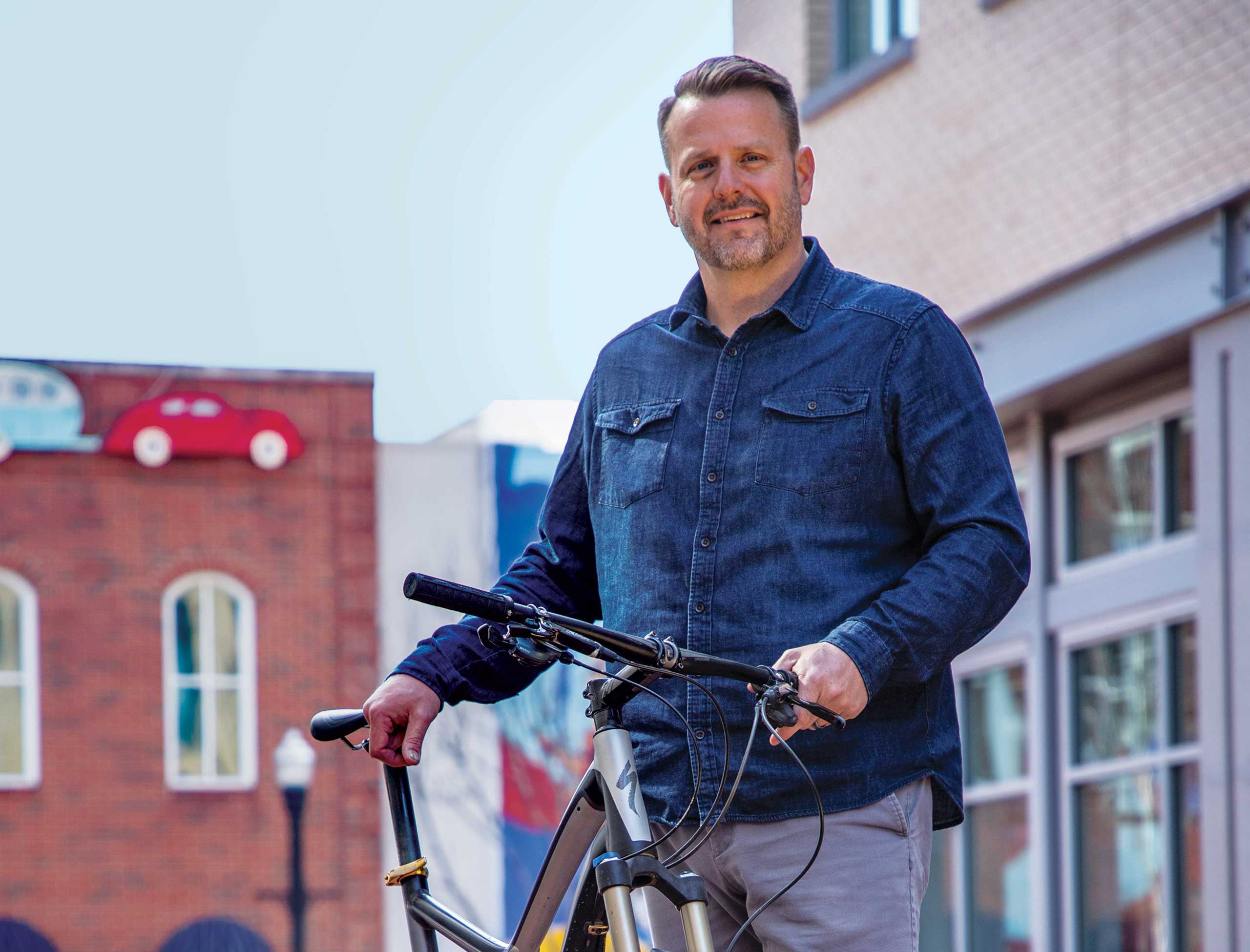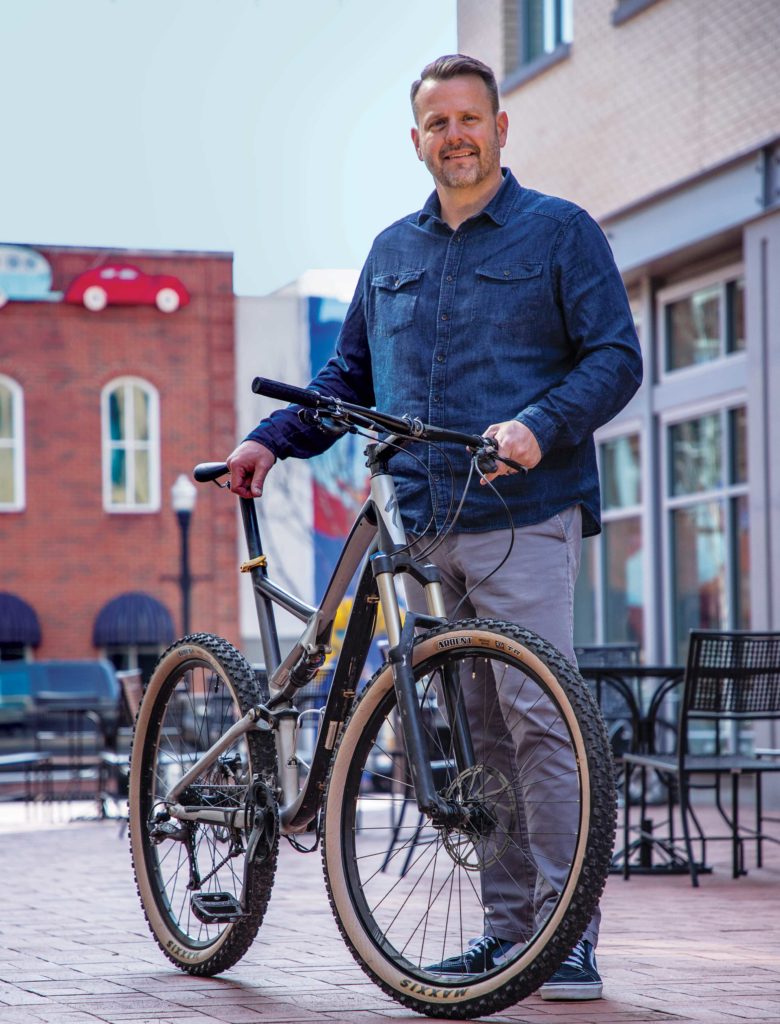
Brick Avenue Lofts, a new 252-unit apartment development in Downtown Bentonville, opens this month. From the earliest planning stages, Ryan Hale, founder of Laneshift, has advised the SREG development team on how to make the property more bike friendly and to expand existing bike infrastructure in the city. Connection Quarterly sat down with Ryan to talk about his role in creating Brick Avenue and his work to make cycling more accessible and inclusive.
CQ: You founded Laneshift in 2017. What does the name Laneshift signify?
RH: Our name and brand really embodies both a physical shift that we can make within our cities and developments to more active forms of mobility as well as an essential shift in thinking and perspectives. As a country we have been hyper focused on a singular mode of transportation and by in large tastes and preferences are shifting. Many people are seeking alternative and active ways to move to work, to school and for play. Laneshift exists to help others broaden their perspectives through intentional and mindful planning and education.
CQ: You’ve challenged us to think of “people on bikes” rather than “cyclists.” Why is this distinction important?
RH: When we hear the word cyclist a certain image comes to mind. Typically this image is of an aggressive rider wearing Lycra, riding a high value bike and charging down the road. While that may be fun and is an important part of a healthy bike ecosystem it is simply not reality or even achievable for most of us. An opportunity exists to shift our thinking and even how we refer to bike users. This slight shift can play a major role in creating more inclusive bike networks and ecosystems. There are infinite reasons why we choose to ride a bike. Bike riding can be a way to be active, have fun and for many is a key tool to connect them to resources, jobs, relationships and community. Referencing bike users as a “person on a bike” or “people on bikes” instead of as a “cyclist” is a subtle but important shift that helps to make each user more real and is a practical way to humanize biking.
CQ: Laneshift has been part of Brick Avenue Lofts since the early planning phases. Please tell us about your role in creating the project.
RH: Our main role within the Brick Ave project was to act as the Mobility consultant. This involved providing insights and consulting that identified opportunities and obstacles in activating and encouraging residents to choose to walk or bike. A focus on stimulating an active lifestyle and moving people was the core of our involvement with Brick Ave. Lofts. An active lifestyle can often become challenging when too many obstacles are present. A few of these obstacles are weather, lack of safe infrastructure, lack of awareness, and perceived safety. Laneshift and the design team collaborated on methods to reduce the obstacles that may prevent a person from choosing an active form of mobility over a single occupancy vehicle. By presenting viable options and reducing and eliminating certain barriers the design team sought to help residents and guests of Brick Ave. choose more active forms of mobility as a first option for transportation, not just for recreation. Laneshift helped provide insights on the overall circulation plan for vehicles, bikes and pedestrians for the site, identified best in class bike parking and storage systems, bike maintenance tools, a bike and pet wash station as well as a bike fleet which includes both pedal powered and ebikes.

CQ: What do we stand to gain from biking more?
RH: There is now an abundance of case studies and evidence highlighting the positive impact that bikes can have on a person, a development, a city and a region. These benefits include improvements to our health, our environment, our economies as well as our overall quality of life. For instance, a recent study commissioned by the Walton Family Foundation showed that Northwest Arkansas realizes a $137 million annual economic benefit that is directly related to bikes. This equates to $86 million in direct health benefits and another $51 million in business benefit through tourism, restaurants, and retail. Those numbers are hard to argue with. In short bikes allow us to connect in a deeper way with our community, get active and improve our quality of life.
Biking for the Rest of Us
Ryan’s tips to get you rolling
- Start small. If biking is not a part of your regular routine don’t try to take on too much all at once or set unrealistic goals. Start small by choosing to replace one or two short trips per month that you would normally take by car with a bike ride. This can be running to the grocery store, dropping by the post office or riding to a local restaurant for dinner. Simply trade what would normally be a car ride with a bike ride. Once you are able to meet those goals for a few months in a row, slowly increase the number of trips you replace over time. You will feel better physically and have a sense of accomplishment.
- Be consistent. If you have not ridden in a while or it’s not a part of your regular routine it will take you a while to build up your strength and endurance. Taking up a new physical activity is hard for the majority of us. That said, keep at it and be consistent by sticking to your goals and slowly increasing those over time. Consistency will build strength and increase endurance which will allow you to travel further than you ever thought possible.
- Don’t stress about special equipment or gear. All it takes to get riding more is a bike. Don’t overthink your attire. Just get on the bike and ride to your destination. If the weather is not cooperating, plan to ride again when things are better. Many beginning riders can get caught up in looking the part and can get sticker shock when trying to purchase specialized gear. Don’t overthink it or worry about what others may or may not think. Get on a bike and go.
The original version of this story by Sarah King appeared in Connection, our quarterly newsletter.


